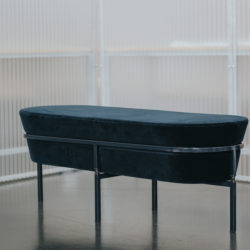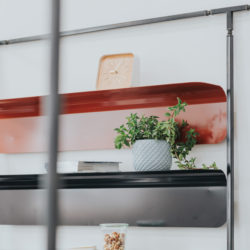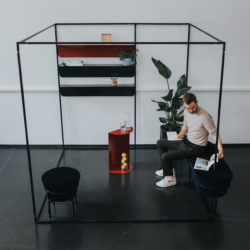Spaces
Description
The work “Spaces” shows one possibility of how the space in between can be redesigned and interpreted to enable interpersonal encounters. For this purpose, a cube was created, which separates the individuals inside and connects them at the same time. People can enter alone or together and create an informal space. Concentrated work as well as heated discussions can transform the room into a third place. Furthermore, the stools "Drop S" and "Drop M" offer a possibility to sit alone or to sit with other people. “Drop L”, on the other hand, invites you to collaborate with its large seat. There is a certain feeling of protection and security, which creates a cozy but also familiar atmosphere that invites you to linger for a longer time and makes you forget the surroundings. Small shelves, such as the "Shell" table or the "Wave" shelves, enable you to discuss and work with your entire body. The plant stand "Coral" improves the indoor climate as well as the air quality through the use of plants. Conversely, this leads to an improved quality of life for the people in the room and increases their productivity. Couple_TB1 forms the possible connection for a large part of the furniture and room constructions mentioned above. In a figurative sense, the space created also forms pairs, which together generate new ideas, build new connections and make collaborative work possible in one place. The good old places, as the sociologist Ray Oldenburg describes pubs, cafés and hairdressers, which a few years ago were places of lively exchange, but can no longer live up to this ideal today, could be in a new place like the "Spaces" designed here and revive the basic ideas of these places. Core message and the resulting ideas could be discussed instantly in a designated place. My design shows one way in which such a space can be filled. Much more, however, it is a kind of construction kit for new rooms and objects, which enables interpersonal work and the resulting encounters.What is the Topic?
The title of this work is "Designing the "third place" and the intermediate zone to enable and promote collaborative work". But what exactly does collaborative work mean in this context and how is it possible to control this process? Thanks to digitalization, office work is undergoing a major transformation and spatially independent work is increasingly becoming part of everyday life. This spatial independence has a strong impact on the topic of work itself, since nowadays project groups located on different continents can work together. This privilege was unthinkable a few years ago and opens up almost unbelievable possibilities. With this freedom, however, a new problem opens up, which can lead to a reduction in productivity. All information can be accessed anytime and anywhere and everything seems at first glance to be close and tangible, but this also means that interpersonal contact quickly moves from the real to the virtual world. Short random or even planned, informal conversations and encounters take place less and less frequently. This one spark, which helps a colleague in the coffee kitchen to solve a previously unsolvable problem, is hard to imagine in a virtual society without random meetings. So how can one channel collaborative work in a real place in a fast-moving and digital age like this one and use the full potential of interpersonal conversation? How can spaces be created, or existing places be designed, to re-initiate such encounters?
Why does it look like this?
After extensive research, the question arose as to which object or piece of furniture best unites the essence of the information gathered and which object best meets the requirements of collaborative work. This decision was not easy to make due to a large number of possibilities, so I chose to aid the external dimensions of a cubical, which is often mentioned in the literature as an enemy of office work. The negative attachment of the Cubical design, which was developed with the best intentions to unleash the full potential of office workers, seemed to me to be a logical consequence of the interior design. Two square meters of space is a quarter of the space (eight square meters) that an employee is entitled to in an office.
What is special?
Space is an all-encompassing concept that can be interpreted in a variety of ways. A room in an apartment, an office, or the interior of a cave. The space of the possible or also the time period in which something is possible. The space of our imagination or the space we need to develop our own personality. There is also our natural habitat and the whole space that surrounds us always and everywhere and around all these spaces, also our earth as the present habitat of all life known to us, space surrounds us. Space is so large that it surpasses the imagination. Spaces are thus, at all times, and unheeded and unnoticed companion of our life. The rooms in which people usually spend the most time are their own homes and workplaces. The space of work is often perceived differently than the space in which one lives. One's own home is the space in which one can develop one's own personality completely irrespective of social conventions. The workspace, on the other hand, can also be a place in which one can act and develop in the same way, or only carry out one activity to cover the daily costs. This feeling is very personal and every working individual feels differently. Work and private life are often separate, with fewer and fewer working people being able or willing to keep their private and professional lives completely separate. A room is thus always a neutral place in itself, only with the activity or other factors connected with it does an atmosphere emerge. A house is bricks, which are piled up to walls and form a closed room with a roof, but this room only becomes a home as soon as furniture and personal belongings fill the room. Life fills a room into a place to which a personal bond can develop. In an office, the same basic conditions prevail at the beginning and yet very few people would assign the same importance to the office as to their home. If additional small rooms are integrated into an office, such as the classic office plot, the mood very quickly drifts into the negative and hardly anyone speaks of a home anymore. Why does such a negative atmosphere develop in the so-called Cubical, why did this type of room become the enemy of an entire professional group? Four square meters of working space with half-height walls develop an enormous effect on a large group of people. The room "Space" uses the dimensions of the Cubicles and unfolds a place where collaborative work and informal togetherness are to be encouraged. Creative thinking does not take place in isolation at a desk, creative processes, and trains of thought develop in interpersonal conversations and contact with others. The space within the room offers certain privacy, it takes the people in it out of the event without isolating them. One remains part of the group, has the opportunity to develop with others without hindering the workflow of the remaining employees. In addition, the entire structure of the room and all objects in it can be assembled manually and without tools. This assembly is further facilitated by the use of the newly designed connector Couple_TB1.
What is new?
New about my work is the attempt to create a space that combines the randomness of a third place with the curated or economic approach of office design. In particular, the "modern" intermediate zones and office landscapes are compared with the criteria of the Third Place according to Ray Oldenburg. Furthermore, the concept of location-independent working is extended to places that do not correspond to the type of workplace in the classical sense. Starting from an urban society in which private and business merge almost inseparably, space has created that attempts to satisfy the needs of both worlds. This space is able to adapt to the environment and the people through a modular design, which makes an almost infinite number of variations possible. The result is a possibility of redesigning the room according to the needs of the users and not an adaptation of the users to the existing furniture.




